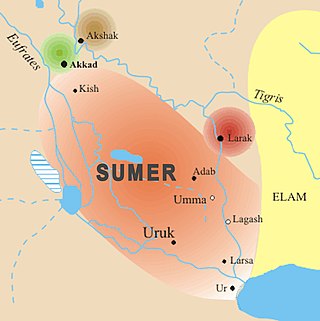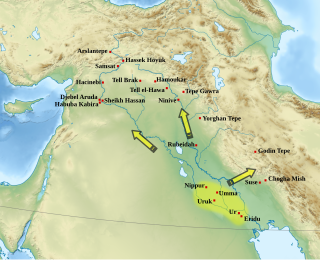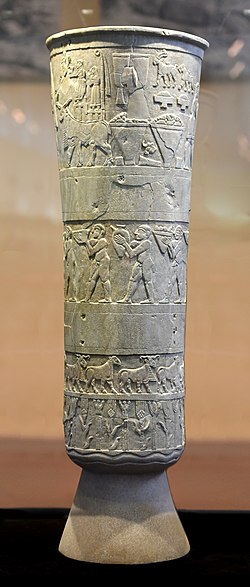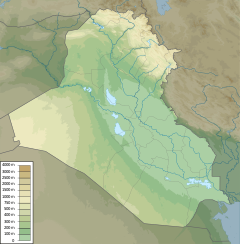
Sumer is the earliest known civilization, located in the historical region of southern Mesopotamia, emerging during the Chalcolithic and early Bronze Ages between the sixth and fifth millennium BC. Like nearby Elam, it is one of the cradles of civilization, along with Egypt, the Indus Valley, the Erligang culture of the Yellow River valley, Caral-Supe, and Mesoamerica. Living along the valleys of the Tigris and Euphrates rivers, Sumerian farmers grew an abundance of grain and other crops, a surplus which enabled them to form urban settlements. The world's earliest known texts come from the Sumerian cities of Uruk and Jemdet Nasr, and date to between c. 3350 – c. 2500 BC, following a period of proto-writing c. 4000 – c. 2500 BC.
Uruk, today known as Warka, was a city in the ancient Near East situated east of the present bed of the Euphrates River on the dried-up ancient channel of the Euphrates. The site lies 93 kilometers northwest of ancient Ur, 108 kilometers southeast of ancient Nippur, and 24 kilometers southeast of ancient Larsa. It is 30 km (19 mi) east of modern Samawah, Al-Muthannā, Iraq.

Nippur was an ancient Sumerian city. It was the special seat of the worship of the Sumerian god Enlil, the "Lord Wind", ruler of the cosmos, subject to An alone. Nippur was located in modern Nuffar 5 miles north of modern Afak, Al-Qādisiyyah Governorate, Iraq. It is roughly 200 kilometers south of modern Baghdad and about 96.56 km southeast of the ancient city of Babylon. Occupation at the site extended back to the Ubaid period, the Uruk period, and the Jemdet Nasr period. The origin of the ancient name is unknown but different proposals have been made.

The Iraq Museum is the national museum of Iraq, located in Baghdad. It is sometimes informally called the National Museum of Iraq. The Iraq Museum contains precious relics from the Mesopotamian, Abbasid, and Persian civilizations. It was looted during and after the 2003 Invasion of Iraq. Despite international efforts, only some of the stolen artifacts have been returned. After being closed for many years while being refurbished, and rarely open for public viewing, the museum was officially reopened in February 2015.

Umma (Sumerian: 𒄑𒆵𒆠ummaKI; in modern Dhi Qar Province in Iraq, was an ancient city in Sumer. There is some scholarly debate about the Sumerian and Akkadian names for this site. Traditionally, Umma was identified with Tell Jokha. More recently it has been suggested that it was located at Umm al-Aqarib, less than 7 km to its northwest or was even the name of both cities. One or both were the leading city of the Early Dynastic kingdom of Gišša, with the most recent excavators putting forth that Umm al-Aqarib was prominent in EDIII but Jokha rose to preeminence later. The town of KI.AN was also nearby. KI.AN, which was destroyed by Rimush, a ruler of the Akkadian Empire. There are known to have been six gods of KI.AN including Gula KI.AN and Sara KI.AN.

Lama, Lamma, or Lamassu is an Assyrian protective deity.

Adab or Udab was an ancient Sumerian city between Girsu and Nippur. It was located at the site of modern Bismaya or Bismya in the Wasit Province of Iraq. The city-god of Adab was Parag'ellilegarra (Panigingarra) "The Sovereign Appointed by Ellil".
Bad-tibira, "Wall of the Copper Worker(s)", or "Fortress of the Smiths", identified as modern Tell al-Madineh, between Ash Shatrah and Tell as-Senkereh and 33 kilometers northeast of ancient Girsu in southern Iraq, was an ancient Sumerian city on the Iturungal canal, which appears among antediluvian cities in the Sumerian King List. Its Akkadian name was Dûr-gurgurri. It was also called Παντιβίβλος (Pantibiblos) by Greek authors such as Berossus, transmitted by Abydenus and Apollodorus. This may reflect another version of the city's name, Patibira, "Canal of the Smiths".

The Uruk period existed from the protohistoric Chalcolithic to Early Bronze Age period in the history of Mesopotamia, after the Ubaid period and before the Jemdet Nasr period. Named after the Sumerian city of Uruk, this period saw the emergence of urban life in Mesopotamia and the Sumerian civilization. The late Uruk period saw the gradual emergence of the cuneiform script and corresponds to the Early Bronze Age; it has also been described as the "Protoliterate period".

The Burney Relief is a Mesopotamian terracotta plaque in high relief of the Isin-Larsa period or Old-Babylonian period, depicting a winged, nude, goddess-like figure with bird's talons, flanked by owls, and perched upon two lions.
Hamoukar is a large archaeological site located in the Jazira region of northeastern Syria, near the Iraqi and Turkish borders. The early settlement dates back to the 5th millennium BCE, and it existed simultaneously with the Ubaid and the early Uruk cultures. It was a big centre of obsidian production. In the 3rd millennium, this was one of the largest cities of Northern Mesopotamia, and extended to 105 ha.

Entemena, also called Enmetena, lived circa 2400 BC, was a son of En-anna-tum I, and he reestablished Lagash as a power in Sumer. He defeated Il, king of Umma, in a territorial conflict through an alliance with Lugal-kinishe-dudu of Uruk, successor to Enshakushanna, who is in the king list. The tutelary deity Shul-utula was his personal deity. His reign lasted at least 19 years.

Zabala, also Zabalam was a city of ancient Sumer in Mesopotamia, located in what is now the Dhi Qar governorate in Iraq. In early archaeology this location was also called Tel el-Buzekh. Locally it is called Tell Bzikh. Zabala was at the crossing of the ancient Iturungal and Ninagina canals, 10 kilometers to the northwest of Umma. The city's deity was Inanna of Zabala. A cuneiform tablet from Zabala contains one of only a few metro-mathematical tables of area measures from the Early Dynastic Period.

The art of Mesopotamia has survived in the record from early hunter-gatherer societies on to the Bronze Age cultures of the Sumerian, Akkadian, Babylonian and Assyrian empires. These empires were later replaced in the Iron Age by the Neo-Assyrian and Neo-Babylonian empires. Widely considered to be the cradle of civilization, Mesopotamia brought significant cultural developments, including the oldest examples of writing.

Karaindaš was one of the more prominent rulers of the Kassite dynasty and reigned towards the end of the 15th century BC. An inscription on a tablet detailing building work calls him “Mighty King, King of Babylonia, King of Sumer and Akkad, King of the Kassites, King of Karduniaš,” inscribed ka-ru-du-ni-ia-aš, probably the Kassite language designation for their kingdom and the earliest extant attestation of this name.

The Blau Monuments are a pair of inscribed stone objects from Mesopotamia now in the British Museum. They are commonly thought to be a form of ancient kudurru.

The Mask of Warka, also known as the Lady of Uruk, dating from 3100 BC, is one of the earliest known representations of the human face. The carved marble female face is probably a depiction of Inanna. It is approximately 20 cm tall, and was probably incorporated into a larger wooden cult image, though it is only a presumption that a deity is represented. It is without parallels in the period. It is in the National Museum of Iraq, having been recovered undamaged after being looted during the United States invasion of Iraq in 2003.
The Uruk Trough is an important Sumerian sculpture found at the site of Uruk, Iraq. It has been part of the British Museum's collection since 1928. Along with the Uruk Vase, the trough is considered to be one of the earliest surviving works of narrative relief sculpture from the Middle East, dating to 3300-3000 BC, during the Uruk period. Simple relief sculpture is known from much earlier periods, from the site of Göbekli Tepe, dating to circa 9000 BC.

The art of Uruk encompasses the sculptures, seals, pottery, architecture, and other arts produced in Uruk, an ancient city in southern Mesopotamia that thrived during the Uruk period around 4200-3000 BCE. The city continued to develop into the Early Dynastic Period (Mesopotamia) around 2900-2350 BCE. Considered one of the first cities, the site of Uruk – modern-day Warka in Iraq – shows evidence of social stratification, institutionalized religion, a centralized administration, and what art historians would categorize as high art and architecture, the first in the long history of the art of Mesopotamia. Much of the art of Uruk shows a high technical skill and was often made using precious materials.
Julius Johann Heinrich Jordan was a German archaeologist active in Mesopotamia before and after the First World War.

























